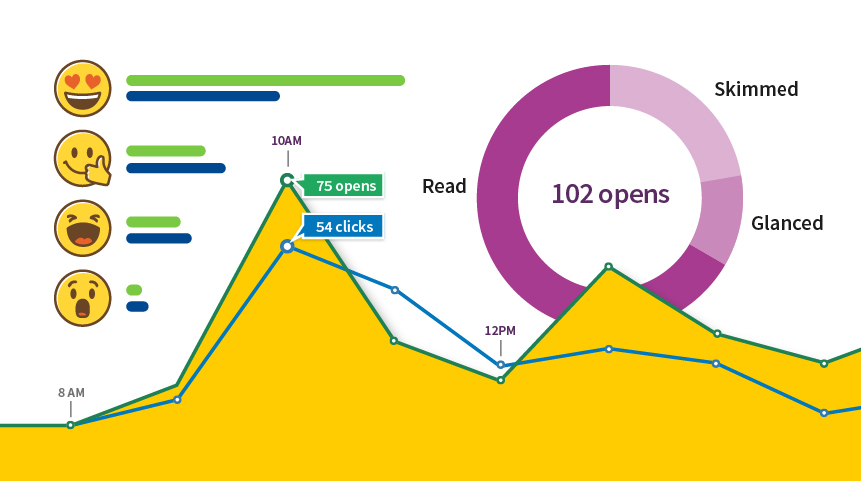In the 2019 Gallagher's State of the Sector Report, nearly 50% of internal communicators surveyed said that a lack of budget and resources for internal communications was a barrier to their success.
45% also reported that they lacked the internal technology they needed to make an impact.
That means there’s a lot of internal communicators out there who don’t have the tools they need to be successful, but also don't have the budget to secure new internal communication tools.
That’s super frustrating.
But don’t worry, all hope is not lost.
In fact, we've seen our own customers overcome this very challenge. And we’re going to show you how they did it.
This is a story from a real Staffbase customer. For privacy and legal reasons, they've asked not to be named, but have agreed to let us tell their story so we can inspire and help other communicators learn from their experiences.
How to use data to make a case for new internal communication technology
Alex is an internal communicator at a biomedical equipment servicing company, communicating to 15,000 employees across the US.
Employee population: 15,000 employees
Industry: Health care
Communication channels: Outlook
Alex and her team were responsible for sending communications to a remote, non-desk based workforce, scattered across the country in various hospitals and health care facilities.
But the only communication channel they had to reach their employees was email.
As you can imagine, this presented some challenges:
- Non-desk employees didn’t have computers at work, so they didn’t actually have anywhere to check their emails.
- Because non-desk employees didn’t have access to computers to regularly check their emails at work, it was impossible to send timely and relevant communications.
- There was a new email for every “important” communication, which meant there was a huge volume of email going out, overloading employees.
- There was no concrete data on the effectiveness of their emails to show leadership and advocate for a new strategy or new tools.
“We didn’t have a good gauge on what emails were working, so we just did whatever: emails twice a day to overlapping audiences.”
How to make a case for new internal communication channels
Alex did her research and thought that maybe an employee app could help her team solve some of their communication challenges.
But Alex also knew that there would be resistance: employee apps can be expensive and there’s always a risk of low adoption.
The expense and the risk would likely be a sticking point for leadership.
So Alex needed to find a way to show leadership that the risk was minimal and the investment was worth it.
Luckily, since email was their main communication channel, it wasn’t too difficult to convince leadership to invest in an employee app with top-notch email capabilities.
The power of a quick win
Alex and her team were able to make a case to leadership that Staffbase Email's measurement features could give them strategic guidance about where they needed to invest more time and potentially more of their budget for better results.
Staffbase’s Employee Email Designer would also give the internal communications team a huge win right away.
Employees had been complaining that the emails they received from corporate weren’t mobile-responsive, which was a particularly big problem if you have a non-desk workforce.
“We know mobile is the future, so we started looking into mobile email design. A lot of our designs weren’t mobile-friendly and we were getting complaints.”
But with Staffbase Email, any email Alex designed would be full-responsive, making an immediate impact on the effectiveness of their communications immediately.
“The emails that we send look great on every device. I really love using the template designer because it is so easy to use. I just drop my content right into the design, bring it over to Outlook, and send it out. I love it.”
Instead of blindly investing in an expensive new app, leadership liked the idea of using data to support their decisions and were excited about being able to implement fully mobile-responsive email templates.
How to use data to support an internal communications audit
To convince leadership to approve an employee app, Alex needed data and a strategy.
By combining Staffbase Email data with insights from internal focus groups and associate surveys, they were able to determine how effective their emails and communications really were and develop a data-backed strategy.
“We used Staffbase Email as a secondary source of data to reconcile what we found out from talking to employees.”
As they guessed, their employees reported being overwhelmed with emails. Staffbase Email backed up this sentiment by showing that their open rates were crawling at 30%.
They had guessed that their engagement probably wasn’t great, but this really shocked them.
But instead of being discouraged about their numbers, Alex and her team saw a golden opportunity.
They decided to test some new internal email tactics and use the data gathered from Staffbase Email to develop and tweak a new internal communication strategy.
How to use data to make a case for an employee app
Soon after they started collecting data with Staffbase Email, Alex’s intuition was proven right.
Mobile usage was considerable: 50% of the email opens were on mobile devices and usage was growing.

And as their email designs became more mobile-friendly, Alex and the team noticed more people were opening the emails. Soon, mobile opens overtook desktop opens altogether.
This was exactly the data Alex needed to show leadership to prove that investing in an employee app was worth it.
“We were able to prove the validity of our idea by using Staffbase Email data to make a case for another mobile communication channel.”
And with data to back them up, Alex and her team were able to win over leadership and get the go-ahead to implement an employee app.
“Without Staffbase Email, we might not have had the data to prove this was a good direction to go in.”
But that doesn’t mean the end of email for Alex and her team.
In fact, they learned in their internal audit that email was still the #1 communication channel their associates preferred.
And as long as email is around, Alex and her team will be using Staffbase Email to make sure their emails are effective and mobile-friendly, and to help measure the success of their communication campaigns.




